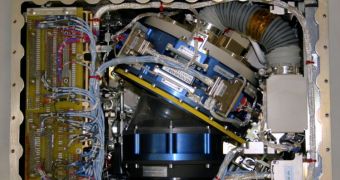Since conducting direct studies of Earth's mantle is impossible with existing technological means, scientists need to think of other ways of confirming their computer models of what is going on under the crust. An experiment developed for this purpose is currently on the orbital lab.
André Kuipers, a flight engineer with the Expedition 31 crew aboard the International Space Station (ISS), is currently conducting a series of observations on this topic using the Geoflow experiment.
The device is made up of two spheres, the inner one mimicking Earth's core, and the outer one its crust, and a fluid located in between, which replicates the behavior of the mantle. The reason that Geflow has to be conducted on the ISS is that it needs to be uninfluenced by gravity.
This enables scientists to use a high-voltage electrical field to create artificial gravity for the experiment. Kuipers is keeping a close eye on what is happening to the liquid between the two spheres.
The main interest here is determining whether it behaves in manners similar to those described by computer models of Earth's mantle, which were compiled from field data and theories. Thus far, data collected from Geoflow confirmed what scientists had already suspected.
The issue with the mantle is that it is a semi-solid fluid made out of molten rock. It extends up to 3,000 kilometers (1,864 miles) below the surface, and displays various layers, each of different depth, temperature and pressure.
Understanding the behavior of the mantle is critical for a large number of reasons. For starters, it could shed more light on the motions of tectonic plates, and explain how and when earthquakes occur, and why. The data could also be used to learn more about how volcanic eruptions take place.
Computer models have already provided geophysicists with a wealth of data on these topics, but the issue is that there was previously no way of confirming the information computers were spitting out.
“As the spheres rotate slowly and a temperature difference is created between the shells, movement in the liquid is closely monitored. The temperatures can be controlled down to a tenth of a degree,” an ESA press release says of how Geoflow works.
“André has seen plumes of hotter liquid rising towards the outer shell – as predicted by computer simulations. Mushroom-like plumes in fluids exposed to strong temperature differences might explain the Hawaiian line of volcanoes in the South Pacific,” the statement adds.

 14 DAY TRIAL //
14 DAY TRIAL //